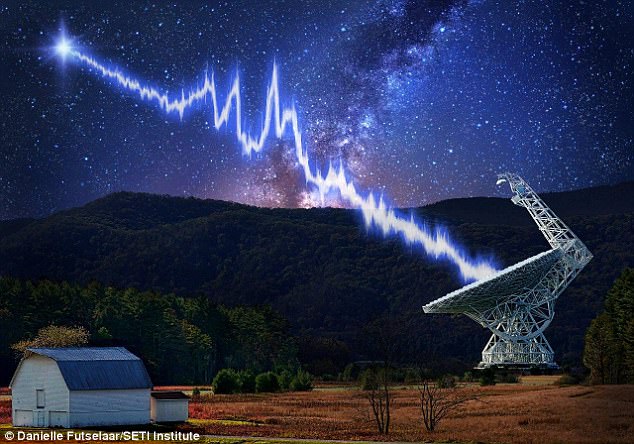They have mystified astronomers for more than a decade, but the source of repeating ‘alien signals’, known as fast radio bursts (FRBs), may finally have been found.
The incredibly strong pulses seem to come from a black hole or an orbiting neutron star with ‘unprecedented power’ three billion light-years from Earth, experts say.
Scientists believe the findings suggest the discovery of an ‘extreme’ environment, which is among the most highly magnetised regions of space ever observed.
However, experts are still not ruling out more unorthodox explanations such as signals coming from an alien civilisation.
Fast radio bursts (FRBs) are brief, bright pulses of radio emissions from distant but so far unknown sources.
They were first detected in 2007 by astronomers scouring archival data from Australia’s Parkes Telescope dating back to 2001.
The 64-metre (200 foot) diameter dish is best known for its role receiving live television images from the Apollo 11 moon landing in 1969.
But the antenna’s detection of the first FRB, and the subsequent confirmed discovery of more than two dozen of the powerful radio pulses across the sky, left astrophysicists baffled.
The catch with FRBs is that they are mostly random and they last for only a few milliseconds – too fast to routinely detect or conduct follow-up observations with radio and optical telescopes.
Only one FRB has been found to repeat, an object known as FRB 121102 in a galaxy about three billion light-years away.
More than 200 high-energy bursts have been observed coming from FRB 121102, since it was first detected in 2012.
An international team of researchers, which included the Breakthrough Listen search for extra terrestrial intelligence (SETI) team at the University of California, Berkeley, used the Robert C. Byrd Green Bank Telescope in West Virginia to study FRB 121102.
They found that the electromagnetic waves that make up the bursts generated by the object conform to a highly unique pattern.
This means they came from somewhere with an incredibly strong magnetic field, like that found around a black hole or neutron star.
Such patterns have only ever been seen in radio emissions from the extreme environments around massive black holes, such as those at the centres of galaxies.
Victoria Kaspi of McGill University, who was part of the study, said: ‘I had to read my email a few times to really digest it.
‘I kept thinking, “No way, that can’t be right”.’
‘We found something that is clearly in an extreme place and the extreme location may create a phenomenon that is one of the biggest astrophysical mysteries of recent times.
‘If you have an extreme object in an extreme environment, is that just a coincidence?
‘FRBs have these huge explosions in radio waves and we don’t know why that occurs.
‘Maybe this is a clue to the mechanism that produces these explosions.’
The findings confirm observations by another team of astronomers from the Netherlands, which detected the polarised bursts using the William E. Gordon Telescope at the Arecibo Observatory in Puerto Rico.












